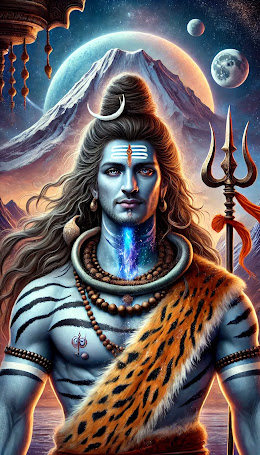Who Is Lord Shiva? Exploring Shiva as Adi Yogi, Mahadev, and Nataraja
Who Is Lord Shiva ? Exploring Shiva as Adi Yogi, Mahadev, and Nataraja
1. Introduction
Lord Shiva, one of the principal deities of Hinduism, has been worshipped and revered in various forms throughout history. He is known as the supreme being in Shaivism and plays a crucial role in the Trimurti as the destroyer and transformer. Over the centuries, different scriptures and traditions have interpreted Shiva in multiple ways. This document explores the various forms of Lord Shiva—Adi Yogi, Mahadev, and others—using references from the Vedas and Puranas, along with historical and geographical contexts.
2. Shiva as Adi Yogi: The First Yogi
Source: Rig Veda (1500–1200 BCE) & Shiva Purana (300–600 CE)
Shiva as the Adi Yogi (the first yogi) represents the origin of yoga and meditation. According to the Shiva Purana:
"Shiva, seated in deep meditation atop Mount Kailash, imparted the knowledge of yoga to the Sapta Rishis." (Shiva Purana, 2.2.38)
Date & Place: This interpretation is traced back to the Rig Veda (1500–1200 BCE) and later expanded in the Puranas. Mount Kailash in present-day Tibet is considered Shiva's abode.
Significance: Adi Yogi symbolizes inner transformation, self-realization, and liberation (moksha).
3. Shiva as Mahadev: The Greatest God
Source: Yajur Veda (1200–900 BCE) & Linga Purana (300–600 CE)
Mahadev means "The Greatest God." The Yajur Veda (Taittiriya Samhita 4.5.1) describes Rudra (Shiva) as:
"We invoke the mighty Rudra, the greatest among gods, the protector of all beings."
Date & Place: 1200–900 BCE (Yajur Veda), refined in later Puranic texts.
Significance: This form of Shiva represents ultimate divinity, the one who is above all gods, granting boons and destroying evil forces.
4. Shiva as Pashupati: The Lord of Beasts
Source: Atharva Veda (1200 BCE) & Harappan Civilization (2600–1900 BCE)
The Atharva Veda (10.8.1) refers to Shiva as Pashupati, meaning "Lord of Beasts":
"Rudra, the lord of all creatures, who controls all living beings."
Date & Place: Mentioned in the Vedas (1200 BCE) and linked to the famous Pashupati seal from the Indus Valley Civilization (Mohenjo-Daro, 2600–1900 BCE).
Significance: This aspect signifies Shiva’s connection with nature, animals, and the universe’s primal energy.
5. Shiva as Nataraja: The Cosmic Dancer
Source: Chidambaram Temple (9th Century CE) & Ananda Tandava Stotra
Shiva as Nataraja (Lord of Dance) symbolizes the cosmic cycles of creation and destruction through his dance, the Tandava.
"In his dance, the universe is born, sustained, and dissolved." (Ananda Tandava Stotra)
Date & Place: The famous Chidambaram Temple in Tamil Nadu (built in the 9th century CE) features this iconic depiction.
Significance: Represents the eternal rhythm of the universe.
6. Shiva as Bhairava: The Fierce Protector
Source: Skanda Purana (700–1200 CE)
Bhairava, a terrifying form of Shiva, is the ultimate protector. The Skanda Purana narrates:
"Bhairava emerged to punish Brahma for his arrogance, severing his fifth head." (Skanda Purana, Chapter 17)
Date & Place: 8th–12th Century CE, primarily worshipped in Varanasi, Ujjain, and Nepal.
Significance: Bhairava protects dharma (righteousness) and punishes evil forces.
7. Shiva as Ardhanarishvara: The Half-Man, Half-Woman Form
Source: Linga Purana (300–600 CE) & Brihannaradiya Purana (1000 CE)
Ardhanarishvara represents the union of Shiva and Shakti (Parvati), symbolizing gender equality and balance.
"Shiva and Shakti, inseparable, embody the universe’s dual nature." (Brihannaradiya Purana, Chapter 42)
Date & Place: Mentioned in Linga Purana (300–600 CE), represented in sculptures at Ellora and Khajuraho temples.
Significance: Signifies harmony between masculine and feminine energies.
8. Shiva as Dakshinamurthy: The Supreme Teacher
Source: Upanishads (400 BCE–200 CE) & Advaita Vedanta (8th Century CE)
Dakshinamurthy is the guru (teacher) form of Shiva. The Upanishads state:
"Seated under the banyan tree, Shiva imparts wisdom in silence to the sages."
Date & Place: Recognized in Upanishads and later in Adi Shankaracharya’s teachings (8th Century CE).
Significance: Symbolizes knowledge, enlightenment, and inner wisdom.
9. Shiva as Neelkanth: The Blue-Throated One
Source: Bhagavata Purana (500–1000 CE) & Samudra Manthan
During the churning of the ocean (Samudra Manthan), Shiva consumed the deadly poison Halahala, turning his throat blue.
"To save creation, Shiva drank the poison, bearing its pain for eternity." (Bhagavata Purana, 8.7.44)
Date & Place: Described in the Puranas (500–1000 CE), associated with Mount Kailash.
Significance: Represents sacrifice and protection of the cosmos.
10. Shiva as Linga: The Formless Divine
Source: Linga Purana (300–600 CE) & Brihadeeswarar Temple (11th Century CE)
Shiva is often worshipped in the form of the Lingam, representing his formless, infinite nature.
"From the infinite Jyotirlinga, creation, preservation, and destruction arise." (Linga Purana 1.17.18)
Date & Place: Established in the Linga Purana, worshipped in Jyotirlinga temples across India.
Significance: Symbolizes divine energy beyond human comprehension.
Lord Shiva is not confined to a single form or role. From the meditative Adi Yogi to the fierce Bhairava, from the cosmic dancer Nataraja to the compassionate Neelkanth, each interpretation offers unique insights into his divine nature. Through the Vedas, Puranas, and historical sites, Shiva continues to be a guiding force, embodying wisdom, transformation, and eternal balance in the universe.
The universe is whispering its secrets—are you ready to listen?
Dare to know more? Enter the realm of cosmic truth.
At the end of this journey, you will never see reality the same way again. Are you ready to break the illusion? Deep dive into www.rudradoota.com
The universe is whispering its secrets—are you ready to listen?
Dare to know more? Enter the realm of cosmic truth.
At the end of this journey, you will never see reality the same way again. Are you ready to break the illusion? Deep dive into www.rudradoota.com













0 Comments:
Post a Comment
Subscribe to Post Comments [Atom]
<< Home